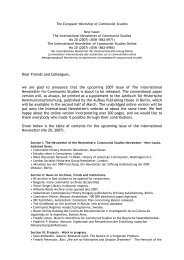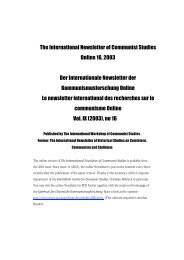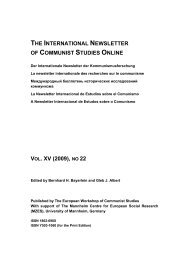Vol. XIII (2007), no 20 - The International Newsletter of Communist ...
Vol. XIII (2007), no 20 - The International Newsletter of Communist ...
Vol. XIII (2007), no 20 - The International Newsletter of Communist ...
Erfolgreiche ePaper selbst erstellen
Machen Sie aus Ihren PDF Publikationen ein blätterbares Flipbook mit unserer einzigartigen Google optimierten e-Paper Software.
<strong>The</strong> <strong>International</strong> Newletter <strong>of</strong> <strong>Communist</strong> Studies Online <strong>XIII</strong> (<strong><strong>20</strong>07</strong>), <strong>no</strong> <strong>20</strong> 38<br />
History is <strong>of</strong>ten judged and written by the winners and the Comintern case has been<br />
perceived by many as a failure. 76 However, contradicting this view one can argue along<br />
Russian historian Apollon Davidson’s line <strong>of</strong> reasoning. 77 First, if communism as an ideology<br />
and factor in world politics during the twentieth century is understood as an important<br />
phe<strong>no</strong>me<strong>no</strong>n, then the Comintern certainly was without doubt one <strong>of</strong> the “most important<br />
global organizations ever to have existed”. Second, the study <strong>of</strong> Comintern, its national<br />
sections (the <strong>Communist</strong> Parties), the organisational structure and its institutional dynamics<br />
(and incapacities), and front organizations represents consequently an essential part in the<br />
history <strong>of</strong> the “short twentieth century”, choosing historian Eric J. Hobsbawm’s limitation in<br />
time in his Age <strong>of</strong> Extremes. 78<br />
<strong>The</strong> LAI was entirely in the hands <strong>of</strong> the communists from its initiation in February 1927<br />
until the Reichstag Fire in Berlin on the 27 February 1933, and with the Nazis finally seizing<br />
ultimate power in the German Weimar Republic, the anti-imperialist network was to be<br />
shredded to pieces. <strong>The</strong> organisational base <strong>of</strong> the LAI was during this whole period located in<br />
Berlin at the <strong>International</strong> Secretariat.<br />
Examination <strong>of</strong> empirical material related to LAI, and filed in the Russian State Archive for<br />
Social and Political History (more k<strong>no</strong>wn as RGASPI, and in which the Comintern archive is<br />
deposited) in Moscow has uncovered a multilayered organization, in which analysis has been<br />
able to distinguish the turmoil that actually existed in a front organization like the LAI. In this<br />
scenario there are individual ambitions by certain actors (both institutional and individual),<br />
whose history to a large degree has been hidden away due to the secret character <strong>of</strong> the<br />
Comintern apparatus, <strong>no</strong>w able to step out into the light, but also, to analyze the major idea<br />
on why the Comintern endorsed so much energy in constructing and keeping a organization as<br />
the LAI alive.<br />
One <strong>of</strong> the major purposes <strong>of</strong> this thesis dissertation is to unveil the organisational<br />
(functional, instrumental, institutional) dimension, and the individual ambitions <strong>of</strong> humans<br />
that were active under the characteristics as “international communists”. 79 With this<br />
ambition, so far during the interpretative process, organisational and individual networks<br />
previously unk<strong>no</strong>wn to the scholarly world started to appear in the relation between LAI’s<br />
<strong>International</strong> Secretariat in Berlin and Comintern headquarters in Moscow. Empirical evidence<br />
confirms assumptions, that the LAI in fact was considered to be an important actor in<br />
facilitating partly the foreign policy interests <strong>of</strong> the Russian Bolsheviks, and, partly acting as a<br />
connective force for the anti-imperialist movement in Europe and other parts <strong>of</strong> the world.<br />
Sources also specify that authorities at Comintern headquarters in Moscow experienced the<br />
LAI as a difficult project to keep under total control, in comparison with the national<br />
76<br />
Jane Degras: <strong>The</strong> <strong>Communist</strong> <strong>International</strong> 1919-1943. Dokuments. I, London 1965, p. IX.<br />
77<br />
Apollon Davidson: South Africa and the <strong>Communist</strong> <strong>International</strong>. A Documentary History. 2 vols.,<br />
London <strong>20</strong>03.<br />
78 Eric J. Hobsbawm: Age <strong>of</strong> Extremes. <strong>The</strong> Short Twentieth Century. 1914-1991, London 1995.<br />
79 <strong>The</strong> term ”international communists” refer to the idea that these persons perceived the whole world<br />
as their working field, all active in the name <strong>of</strong> communism.














